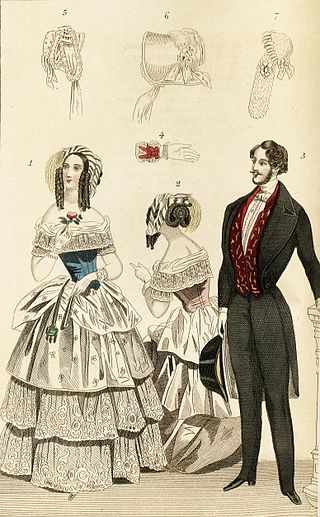
Victorian fashion consists of the various fashions and trends in British culture that emerged and developed in the United Kingdom and the British Empire throughout the Victorian era, roughly from the 1830s through the 1890s. The period saw many changes in fashion, including changes in styles, fashion technology and the methods of distribution. Various movement in architecture, literature, and the decorative and visual arts as well as a changing perception of gender roles also influenced fashion.
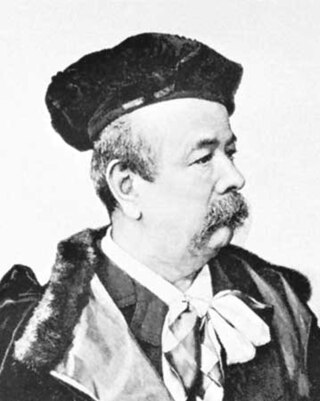
Charles Frederick Worth was an English fashion designer who founded the House of Worth, one of the foremost fashion houses of the 19th and early 20th centuries. He is considered by many fashion historians to be the father of haute couture. Worth is also credited with revolutionising the business of fashion.
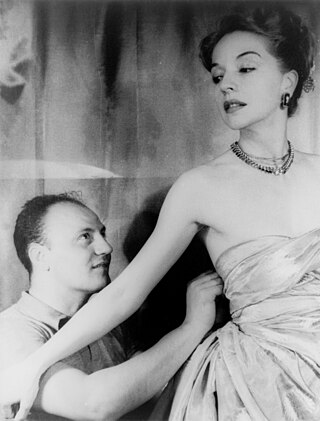
A dressmaker, also known as a seamstress, is a person who makes clothing for women, such as dresses, blouses, and evening gowns. Dressmakers were historically known as mantua-makers, and are also known as a modiste or fabrician.

Panniers or side hoops are women's undergarments worn in the 17th and 18th centuries to extend the width of the skirts at the side while leaving the front and back relatively flat. This provided a panel where woven patterns, elaborate decorations and rich embroidery could be displayed and fully appreciated.

1850s fashion in Western and Western-influenced clothing is characterized by an increase in the width of women's skirts supported by crinolines or hoops, the mass production of sewing machines, and the beginnings of dress reform. Masculine styles began to originate more in London, while female fashions originated almost exclusively in Paris.

History of fashion design refers specifically to the development of the purpose and intention behind garments, shoes, accessories, and their design and construction. The modern industry, based around firms or fashion houses run by individual designers, started in the 19th century with Charles Frederick Worth who, beginning in 1858, was the first designer to have his label sewn into the garments he created.
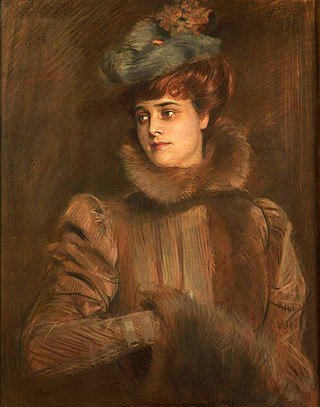
Louise Chéruit, also known as Madame Chéruit and often erroneously called Madeleine Chéruit, was a French fashion designer. She was among the foremost couturiers of her generation, and one of the first women to control a major French fashion house. Her salon operated at Place Vendôme in Paris under the name Chéruit from 1906 to 1935. She is best remembered today as the subject of a number of portraits by Paul César Helleu and for the appearance of her name in two celebrated works of literature, Marcel Proust's Remembrance of Things Past (1910) and Evelyn Waugh's Vile Bodies (1930). Her name is also frequently associated with the fashion photography of Edward Steichen, whose favorite model, Marion Morehouse, often wore gowns from the house of Chéruit for Vogue magazine in the 1920s. One particular Steichen image has become iconic – Morehouse in a jet-beaded black net Chéruit dress, first published in 1927.
Madame Grès (1903–1993), also known as Alix Barton and Alix, was a leading French couturier and costume designer, founder of haute couture fashion house Grès as well as the associated Parfums Grès. Remembered as the "Sphinx of Fashion", Grès was notoriously secretive about her personal life and was seen as a workaholic with a furious attention to detail, preferring to let her work do the talking. Grès, best known for her floor-length draped Grecian goddess gowns, is noted as the "master of the wrapped and draped dress" and the "queen of drapery". Grès's minimalistic draping techniques and her attention to and respect for the female body have had a lasting effect on the haute couture and fashion industry, inspiring a number of recent designers.
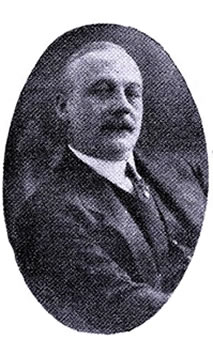
Georges Camille Doeuillet was one of France's best known couturiers along with his peers Louise Chéruit, Jeanne Paquin, Paul Poiret, Redfern & Sons and the House of Charles Worth.

The House of Worth was a French fashion house that specialized in haute couture, ready-to-wear clothes, and perfumes. It was founded in 1858 by English designer Charles Frederick Worth. It continued to operate under his descendants until 1952 and closed in 1956. Between 2010 and 2013 there was an attempt to relaunch the House of Worth as a fashion brand.

A Eugénie hat is a small women's hat that is usually worn tilted forwards over the face, or it may be angled low over one eye. Typically, it is made of velvet or felt, although a variety of materials may be used. The classic design also has a plume of feathers, although other trims may be used.

Louis Hippolyte Leroy (1763–1829) was a French fashion merchant who founded the House of Leroy, one of the foremost fashion houses of the early 19th century First Empire Paris. He is known as the favorite fashion trader and the official fashion designer of empress Josephine de Beauharnais. He was very successful and also provided dresses for several other royal and Princely courts in Europe during the early 19th century.
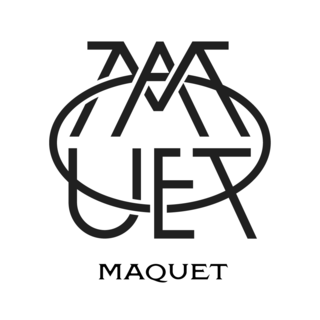
Maquet is a French manufacturer of luxury stationery, leather goods, and art prints, established in Paris, in 1841 by the Maquet brothers, Hector and Charles. One of the most renowned Parisian luxury houses, Maison Maquet became official purveyor to Empress Eugénie as well as to several royal courts, winning multiple awards and medals at various World's fairs over the course of its history.
Madame Palmyre also called Mademoiselle Palmyre, was a French fashion designer couturier.
Madame Victorine (19th-century), was a French fashion designer couturier.
Madame Herbault, was a French fashion designer (milliner).
Madame Virot (1826-1911) was a French fashion designer milliner. Alongside Caroline Reboux, she was one of the two most famous hat designers in Paris during the second half of the 19th-century.

Jeanne Victorine Margaine-Lacroix was a French couturier of the early 20th-century. The House Margaine-Lacroix is mainly known today for having revolutionized the world of fashion by creating the so-called Sylphide or Tanagréenne dress, cut to be worn without a corset.
Madame Laferrière (19th-century) was a French fashion designer milliner. She belonged to the elite of the French fashion industry during the Second Empire.
Mademoiselle Félicie (19th-century) was a French fashion designer milliner. She belonged to the elite of the French fashion industry during the Second Empire.


















